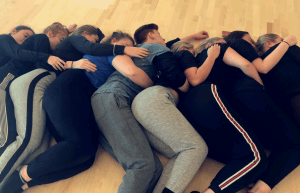After last week’s class our group decided to focus and explore the concept of senses in CI. Our question was: How are the senses heightened or forgotten when moving through improvisation with vision or without? We set 2 tasks for the group to complete which was; lead and follow and finish the image, both exercises were performed with the eyes open and closed. To answer our main question, we asked these questions;
Which connection was stronger with your partner, eyes opened or closed? And why?
Did you feel different?
Did you create different movement?
Which senses were heightened, and which were forgotten?
Could you hear anyone else in the room that was near you?
The feedback showed us that the senses are easily forgotten, and that we rely on our vision a lot when improvising with another person. Depending on the activity, feelings changed on what they preferred: eyes opened or closed. The first exercise was easy with the eyes opened and closed, however it was easier to move with the eyes closed, because it allowed them to relax and not think about what to do next. In the second there was more experimentation with the eyes closed, but there was a boundary of not wanting to push yourself too much, because of not knowing where the other person was and cause an injury. When trying to find their partner, they mentioned that their touch and sound was heightened compared to when their eyes are opened, although they could still use their sight even though they could not physically see. To work out how close their partner was to them, they used the shadows that the other person was creating. Besides all of this, at one point of the activity they were not aware of any of their senses, because they were concentrating on creating movement and keeping contact. They also forgot there was people in the space apart from them two. Therefore, touch was heightened because they knew someone was there, they were just not aware of this sense it was just a subconscious thought. Overall, everyone thought they had a stronger connection with their eyes open, however their connection was still strong when they were closed. They were connecting with each other by listening to each other’s bodies through touch, they were just not aware of this.
Before class I did not understand anything in Is Contact a Small Dance? However, after the class it made more sense because sometimes seeing things makes it clearer. The video of Steve Paxton’s small dance made me realise we never stop moving, even when we are stood still. Therefore, is this motion called small dance, because of how little and non-visible the movement is?
Putting the reading and video to practice, I was aware of the sensation of moving. When listening to my body I would notice small details like; fingers twitching, knees bending and muscles activating. When I swayed backwards I noticed my right knee lock to re-centre myself. Although, I did not feel centred, I had the sensation of my body falling forward and I was not upright. Sometimes when moving I was not aware of what I was doing, I was listening to my body and letting the body do what it wanted. The rest of the time I could feel myself forcing the moves and it was not the authentic movement of my body. After the exercise my awareness of moving was heightened and I felt like I was swaying more than what I was at the beginning.
Two things interested me in Sensing weight in movement, I can influence how I feel, move, and weigh by imagining something, and I feel this will help create new movement for myself. The second thing was ‘What a dancer senses is a function of how the dancer moves, and how the dancer moves is a function of what he or she senses’ (Fuchs and De Jaegher, 2009, 472). I understand what this means, but I do not know how to explain it but the quote really stood out to me.
I worked with many different people this week and I feel comfortable with all of them. I think I have pushed past the boundary of ‘hesitation, vagueness, and insecurity that is usually a hindrance to building a dance together’ (Paek, 2015, 36).
Brown, B. Is Contact a Small Dance? Contact Improvisation Sourcebook I. Vol. 6 Pp. 72-75
Fuchs, T and De Jaegher, H. (2009) Enactive intersubjectivity: participatory sense-making and mutual incorporation. Phenomenology and the Cognitive Sciences, 8: 4, pp. 465–86
Paek, S M. (2015) Beginning, Approaching, Practicing, Dancing. Contact Quarterly, Vol 40: 1,pp. 36.
Ravn, S. (2010) Sensing weight in movement. Journal of Dance & Somatic Practices. Vol. 2 Issue 1, p21-34, 14p.
ZayacZhe. (2009) steve paxton. Smalldance. Available from https://www.youtube.com/watch?v=6sJKEXUtv44 [accessed 20 September 2017].
